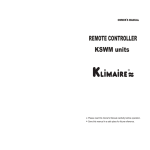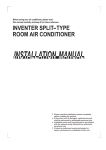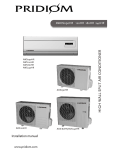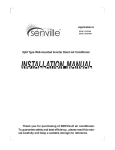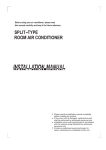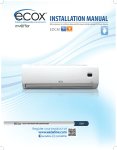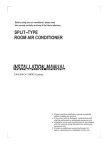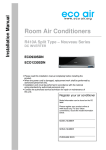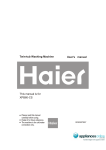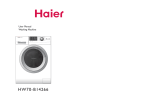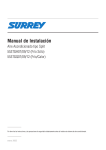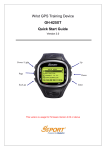Download Installation Manual 18-24.cdr - Thermospace air conditioners
Transcript
Installation Parts KSWM series INSTALLATION MANUAL FOR ROOM AIR CONDITIONER (Split Wall Mounting Type) For correct installation, read this manual before starting installation. Please save this manual in a safe place. Only trained and qualified service personnel should install, repair or service air conditioning equipment. Users should not install the air conditioner by themselves. Pictures in this manual may be slightly different from the air conditioner you purchased. These pictures are only sketches. Part No. Name of part Q'ty 1 2 3 4 5 6 Installation plate Clip anchor Mounting screw A ST3.9x25-C-H Remote controller Remote controller holder Mounting screw B ST2.9x10-C-H 1 8 8 1 1 2 7 Refrigerant pipe Liquid side Gas side 24000Btu/h) 9.53( 24000Btu/h) 12.7( 24000Btu/h) 16( Before installation, operate the remote controller to determine its location in a reception range. Keep the remote controller at least 1m apart from the nearest TV set or stereo equipment. Do not install the remote controller in a place exposed to direct sunlight or close to a heating source, such as a stove. Note that the positive and negative poles are right positions when loading batteries. 24000Btu/h) Seal Drain elbow 8 9 INSTALLATION PRECAUTION 6.35( Cautions on remote controller installation Installation in the following places may cause trouble. If it is unavoidable to use in such places, please consult with the dealer: A place full of machine oil. A saline place such as coast. A place full of sulfide gas such as hot-spring resort. Places where there are high frequency machines such as wireless installation, welding machine, and medical facility. A place of special environmental conditions. Indoor Unit 3 12cm 2 or mo r 15c e ma bov e 1 12cm Air Outdoor Unit filte Ai r r C le an e or mo re r 4 A place, which is convenient to installation and not exposed to a strong wind. A place can bear the weight of the outdoor unit and where the outdoor unit can be held in the horizontal position. A place where the operation noise and discharge air do not disturb you neighbor. A place free of a leakage of combustible gases. An allowable head level at the connective piping is less than 5m and length of the connective piping is up less than 10m. A place, which provides the spaces around the outdoor unit as required right in the diagram. Unavailable to children. Remote Controller Caution Mounting screw B ST2.9X10-C-H 7 The outdoor unit should not be exposed to strong wind. Fix the outdoor unit with 10 anchor bolts. Remote controller holder 6 or mo r e A air inlet 60cm or more 30cm A 5 30cm o or m re B A place where is no obstacle near the inlet and outlet area. A place which can bear the weight of the indoor unit. A place which provides the spaces around the indoor unit as required right in the diagram. A place 1m or more from TV, radio instrument, in the center of the room is perfect. A place which is far from heat, steam and inflammable gas. Install the indoor unit on the wall where the height from the floors more than 2.3 meters. m or 200c air outlet more 60cm B NOTE: 1. The appliance shall not be installed in the laundry. All the connection must be in accordance with national regulations. 2. For detailed installation acceptance, please refer to your contract with the power supplier if restrictions do apply for products like washing machines, air conditioners or electrical ovens. 3. For power details of the air conditioner, refer to the rating plate of the product. Contact your local dealer if you have any questions. or mo re C Model A B 24000Btu/h 560 335 24000Btu/h 590 333 Loop the connective cable. If need suspending installation, consults the corresponding requirement. Remove the water receiver first before connecting the pipes. NOTICE: There should be at least two of the A, B, C direction are free from blocking. 1 INDOOR UNIT INSTALLATION 1. Cutting A Hole and Mounting Installation Plate 2. Connective Pipe and Drainage Installation Installation Plate and Its Measures (Unit: mm) Above 150 from the ceiling Pipe hole 58 1. For the left-hand and rear-left-hand piping, install the piping as shown. Bend the connective pipe to be laid at 43mm height or less from the wall. Above 120 from the wall Indoor unit outline 55 55 Indoor unit outline Pipe hole 1. Fix the installation plate. 1. Determine the pipe hole position using the installation plate, and drill the pipe hole ( 95mm ) so it slants slightly downward. 2. Always use a piping hole cap when piercing a wall, made of metal lath, wire lath or metal plate. . .. . . .. . .. . .. .. .. . . .... . .. .... .. ..... ..... ..... .... . ......... ........... ............. .... .............. ......... .. .... Do not put the drain end into water. Do not form a rise. 2. Cutting a hole. 1. Install the installation plate horizontally on structural members in the wall with the spaces provided around the plate. 2. In case of block, brick, concrete or similar type walls, make 5mm dia, holes in the wall. Insert clip anchors for appropriate mounting screws. 3. Fix the installation plate on the wall. Shield pipe Caution Wall Connect the indoor unit first then the outdoor unit. Bend and arrange the pipe carefully. Insulate both of the auxiliary piping. Drainage can not annoy your neighbor. Extension drainhose Drain hose Inside the room 5. Connecting Cables Prepare the power source for exclusive with the air conditioner. The supply voltage must be the same as the rated voltage of the air conditioner. Model 1. Pass the piping through the hole in the wall. 2. Put the upper claw at the back Low hook of the indoor unit on the upper hook of the installation plate, Move the indoor unit from side to side to see that it is securely hooked. 3. Push the lower part of the indoor unit up on the wall. 4. Piping can easily be made by lifting the indoor unit with a Cushioning material cushioning material at the remote controller holder side between the indoor unit and the wall. Upper hook 24000Btu/h 24000Btu/h Input Rated Amp (Switch/Fuse) Power Supply 220-230V~ 60Hz or 220-240V~ AWG(MIN.) Power Supply cord 32/20A 12 50Hz .. .. . .. ......... ... 2. Fix the end of the connective pipe. 2. When connecting extension drain hose, insulate the connecting part of extension drain hose with a shield pipe. 4. Electrical Work 3. Indoor unit Installation Connec tive pipe 43 95 95 2. Connective pipe 1. Run the drain hose sloping downward. Do not install the drain hose as illustrated below. 257 55 Above 120 from the wall 1250 815 325 178 1. Drainage Hooked Part Hooker Part Connecting cable 1. Lift the panel, loose the screw then open the Electric Box Cover. 2. Connect the wires to the terminals on the control board individually according to the outdoor unit connection. 3. Wrap those cables not connected with terminals with insulation tapes, so that they will not touch any electrical components. 18 Panel 32/25A NOTE: A disconnection device having an air gap contact separation at least 3mm in all conductors should be incorporated in the fixed wiring according to the National Wiring Regulation. Caution Perform the wiring with sufficient capacity. Installation places legally require a short circuit isolator to be attached to prevent electrical shock. Do not extend the power cable code by cutting. The plug of the air conditioner takes a grounding leg, so clients should use a grounding socket so that the air conditioner can be grounded efficiently. Terminal block 1 2(N) S G Code wire 10mm To outdoor unit 40mm Terminal block of indoor unit INDOOR UNIT INSTALLATION 1 6. Piping and Bandaging Caution 1. For the left-hand and right-hand piping, remove the rear plate bushing from the left side of the rear plate. Explain to clients that the rear plate bushing must be kept as it may be used when relocate the air conditioner to any other place. 2. Wind the connective cable, drain hose and wiring with tape securely, evenly. Rear-right piping Install the drain hose at the bottom of the connective cable. Reasonably and carefully arrange and bandage the piping in case to damage the drain hose and connective piping. Connec tive piping ... .. .. ... ...... . ... . . .. . . ... . . .... .. . ... . . . ..... Right-hand piping Left-hand piping Connec tive cable Drain hos e Tape Make sure to run the drain hose sloped downward to drain out the condensation smoothly. Never intercross nor inter twist power line with any other wiring. Rear-left piping Slid Part cover OUTDOOR UNIT INSTALLATION 2 1. Outdoor Installation Precaution 2. Drain Elbow Installation Install the outdoor unit on a rigid base to prevent increasing noise level and vibration. Strong wind Determine the air outlet direction where the discharged air is not blocked. In the case that the installation place is exposed to strong wind such as X a seaside or high position, secure the normal fan operation by putting the unit lengthwise along the wall or using a dust or shield plates. Specially in windy area, install the unit to prevent the admission of wind. If need suspending installation, the installation wall should be solid brick, concrete or the same intensity construction, or actions to reinforce, damping, supporting should be taken. The connection between bracket and wall, bracket and the air conditioner should be firm, stable and reliable. If need suspending installation, the installation bracket should accord with technique requirement in the installation bracket diagram. 2. Tightening Connection 1. Flaring 1. Cut a pipe with a pipe cutter. Oblique Rough-mess Align pipes to be connected. Sufficiently tighten the flare nut with fingers, and then tighten it with a spanner and torque wrench as shown. Burr Caution 2. Insert a flare nut into a pipe and flare the pipe. A Excessive torque can break nut depending on installation conditions. Outlet diam. A (mm) Max. Min. 1.3 0.7 2 1.8 1.0 1.8 2.2 2.4 Outlet diam. (mm) 6.35 9.53 12.7 16 O Base pan hole of outdoor unit Drain elbow Seal Seal Drain pipe 4. Wiring Connection 3. Refrigerant Piping Connection ¡£ 90 Fit the seal into the drain elbow, then insert the drain elbow into the base pan hole of outdoor unit, rotate 90 to securely assemble them. Connecting the drain elbow with an extension drain hose (Locally purchased), in case of the water draining off the outdoor unit during the heating mode 6.35mm 9.53mm 12.7mm 16mm Tightening torque 1570(N.cm) (160kgf.cm) 3040(N.cm) (310kgf.cm) 4900(N.cm) (500kgf.cm) 7360(N.cm) (750kgf.cm) Additional tightening torque 1960(N.cm) (200kgf.cm) 3430(N.cm) (350kgf.cm) 5390(N.cm) (550kgf.cm) 7850(N.cm) (800kgf.cm) 1. Remove the cover control from the unit by loosening the 3 screws. 2. Dismount caps on the conduit panel. 3. Temporarily mount the conduit tubes (not included) on the conduit panel. 4. Properly connect both the power supply and low voltage lines to the corresponding terminals on the terminal block. 5. Ground the unit in accordance with local codes. 6. Be sure to size each wire allowing several inches longer than the required length for wiring. 7. Use lock nuts to secure the conduit tubes. Outdoor unit Terminal block Ove r4 G Connecting cable Power supply cord Cover control WARNING Be sure to comply with local codes while running the wire from the indoor unit to the outdoor unit. Every wire must be connected firmly. No wire should be allowed to touch refrigerant tubing, the compressor or any moving parts. Loose wiring may cause the terminal to overheat or result in unit malfunction. A fire hazard may also exit. Therefore, be sure all wiring is tightly connected. Terminal block G Choose purge method from the table: Connective pipe length Air purging method Less than 5m Use vacuum pump 5 ~ 10m Use vacuum pump Additional amount of refrigerant to be charged (L-5)X30g When relocate the unit to an other place, perform evacuation. using vacuum pump . For the R407C/R410A refrigerant models, make sure the refrigerant added into the air conditioner is liquid form in any case. Caution in Handing the Packed Valve Open the valve stem until it hits against the stopper. Do not try to open it further. Securely tighten the valve stem cap with a spanner or the link. Valve stem cap tightening torque. (See Tightening torque table above) Outdoor unit Refrigerant A Indoor unit Gas side C Liquid side D 1. Completely tighten the flare nuts A, B, C, D, connect the manifold valve charge hose to a charge port of the packed valve on the gas pipe side. 2. Connect the charge hose connection to the vacuum pump. 3. Fully open the handle Lo of the manifold valve. 4. Operate the vacuum pump to evacuate. After starting evacuation, slightly loose the flare nut of the packed valve on the gas pipe side and check that the air is entering. (Operation noise of the vacuum pump changes and a compound meter indicates 0 instead of minus ) 5. After the evacuation is complete, fully close the handle Lo of the manifold valve and stop the operation of the vacuum pump. Make evacuation for 15 minutes and more and check that the compound meter indicates -76cmHg. 6. Turn the stem of the packed valve B about 45Ocounterclockwise, securely tighten the flare nut after 6-7 seconds. Disconnect the charge hose from the charge connection of the packed valve at the gas pipe side. 7. Fully open the packed valves B and A. 8. Securely tighten the cap of the packed valve. B Packed valve Manifold valve Half union Flare nut Compound meter L N G Cord clamp Cap (remove) Power supply line To indoor unit Pressure gauge 2. Gas Leak Check 3. Test Operation Make sure no gas from connections with leak detector or soap water. Indoor unit check point D C B A Electrical box Outdoor unit check point Caution A: Lo packed valve B: Hi packed valve C and D are ends of indoor unit connection. Perform test operation after completing gas leak check at the flare nut connections and electrical safety check. 1. Connect the power, push the ON/OFF button on the remote controller to begin testing. 2. Push mode button, select cooling, heating, fan mode to check if all the functions works well. 3. When the ambient temperature is too low (lower than 17 ) , the unit cannot be controlled by the remote controller to run at cooling mode. At this time, manual operation can be taken. 1) Open the front panel of the indoor unit; 2) Connect the power, the air conditioner ++begin to operate, check if there is any ++abnormal. +A protection feature prevents the air conditioner from being activated for about 3 minutes when it is restarted immediately after operation or when the power switch is turned on. 4. Be sure to set the manual switch on OFF after finishing the test operation. Then installer should explain how to manipulate, fix, and maintain their air conditioner. Also tell them that regular check of the installation bracket and maintenance are necessary. Clients should apply for inspecting to relevant department so as to ensure the air conditioner can operate normally, safely and reliably. -76cmHg Handle Lo Stopper Cap 1 2( 2(N N)) S AIR PURGE AND TEST OPERATION Using the Vacuum Pump (For method of using a manifold valve, refer to its operation manual) 1. Air Purge Conduit panel G Note : To prevent wires loosening or leaving the Cord Clamp, please select proper cord diameter to fill the holes on the cord clamp. 3 0mm Charge hose Handle Hi Charge hose Vacuum pump Valve body Valve stem Packed valve at the gas pipe side Manual switch


